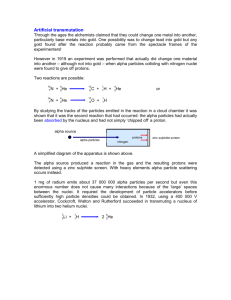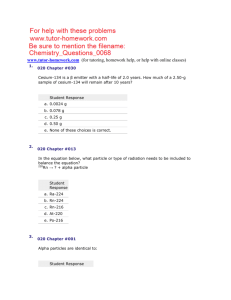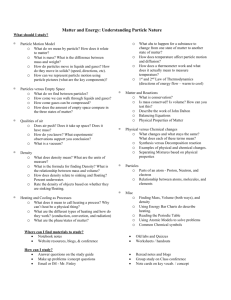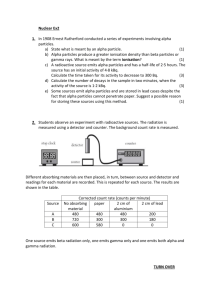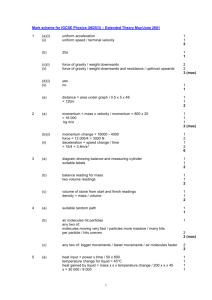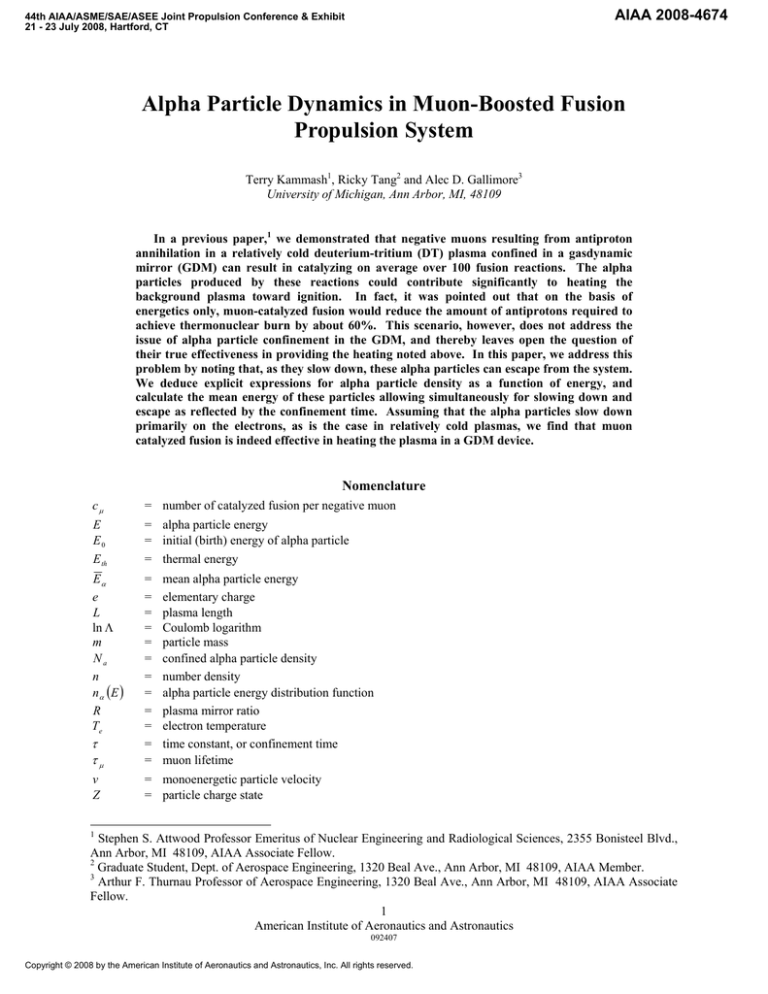
AIAA 2008-4674
44th AIAA/ASME/SAE/ASEE Joint Propulsion Conference & Exhibit
21 - 23 July 2008, Hartford, CT
Alpha Particle Dynamics in Muon-Boosted Fusion
Propulsion System
Terry Kammash1, Ricky Tang2 and Alec D. Gallimore3
University of Michigan, Ann Arbor, MI, 48109
In a previous paper,1 we demonstrated that negative muons resulting from antiproton
annihilation in a relatively cold deuterium-tritium (DT) plasma confined in a gasdynamic
mirror (GDM) can result in catalyzing on average over 100 fusion reactions. The alpha
particles produced by these reactions could contribute significantly to heating the
background plasma toward ignition. In fact, it was pointed out that on the basis of
energetics only, muon-catalyzed fusion would reduce the amount of antiprotons required to
achieve thermonuclear burn by about 60%. This scenario, however, does not address the
issue of alpha particle confinement in the GDM, and thereby leaves open the question of
their true effectiveness in providing the heating noted above. In this paper, we address this
problem by noting that, as they slow down, these alpha particles can escape from the system.
We deduce explicit expressions for alpha particle density as a function of energy, and
calculate the mean energy of these particles allowing simultaneously for slowing down and
escape as reflected by the confinement time. Assuming that the alpha particles slow down
primarily on the electrons, as is the case in relatively cold plasmas, we find that muon
catalyzed fusion is indeed effective in heating the plasma in a GDM device.
Nomenclature
cμ
= number of catalyzed fusion per negative muon
E
E0
= alpha particle energy
= initial (birth) energy of alpha particle
= thermal energy
E th
Eα
e
L
ln Λ
m
Na
n
n α (E )
R
Te
τ
τμ
v
Z
=
=
=
=
=
=
=
=
=
=
=
=
mean alpha particle energy
elementary charge
plasma length
Coulomb logarithm
particle mass
confined alpha particle density
number density
alpha particle energy distribution function
plasma mirror ratio
electron temperature
time constant, or confinement time
muon lifetime
= monoenergetic particle velocity
= particle charge state
1
Stephen S. Attwood Professor Emeritus of Nuclear Engineering and Radiological Sciences, 2355 Bonisteel Blvd.,
Ann Arbor, MI 48109, AIAA Associate Fellow.
2
Graduate Student, Dept. of Aerospace Engineering, 1320 Beal Ave., Ann Arbor, MI 48109, AIAA Member.
3
Arthur F. Thurnau Professor of Aerospace Engineering, 1320 Beal Ave., Ann Arbor, MI 48109, AIAA Associate
Fellow.
1
American Institute of Aeronautics and Astronautics
092407
Copyright © 2008 by the American Institute of Aeronautics and Astronautics, Inc. All rights reserved.
I. Introductory Remarks
W
1
e have shown in previous work that in antiproton-driven fusion propulsion systems, plasma heating results
from fission fragments as well as from the annihilation products produced by antiproton annihilation in U238
targets. We have also indicated that some additional significant heating comes about as a result of muon catalysis in
a deuterium-tritium (DT) plasma whereby a negative muon can uniquely attach itself to both D and T ions, thereby
allowing them to undergo fusion reactions and releasing energetic alpha particles into the plasma. Such catalysis
results in more than 100 fusion reactions during the lifetime of the muon, and the resulting alpha particles provide
sizable amount of heating towards ignition. The assumption made in those studies is that the alpha particles in the
confinement device – the gasdynamic mirror (GDM) – deposit their energy through collisions and not escape while
doing so. In this paper, we address this question by allowing for escape while these particles slow down. We
assume that alpha particle confinement follows that of the ions, and deduce the appropriate expressions for their
velocity distribution and mean energy, as well as their confinement time in the GDM. We find that despite particle
losses, the fraction of alpha particles that are confined can still contribute a significant amount of plasma heating as
suggested earlier. What follows is a mathematical confirmation of these predictions.
II. Energy Distribution
The number of alpha particles in an interval of energy ΔE is nα (E )ΔE , where nα (E ) is the number density per
unit energy. If a loss mechanism has a time constant τ s (E ) , then in steady state we have
d
[nα (E )ΔE ] = nα (E )⎛⎜ dE ⎞⎟ − nα (E + ΔE )⎛⎜ dE ⎞⎟ − nα (E )ΔE = 0
dt
τ (E )
⎝ dt ⎠ E
⎝ dt ⎠ E + ΔE
(1)
Rearranging and using the definition of a derivative, we obtain the following governing differential equation for
the energy distribution of alpha particles.
∂ ⎛ dE ⎞ nα (E ) ∂nα ⎛ dE ⎞
∂ ⎛ dE ⎞ nα (E )
=
=0
⎜ nα
⎟+
⎜
⎟ + nα (E ) ⎜
⎟+
∂E ⎝
dt ⎠ τ (E )
∂E ⎝ dt ⎠
∂E ⎝ dt ⎠ τ (E )
(2)
Integrating Eq. (2) over the range of energies E to E 0 , where E 0 is the initial energy (i.e. birth energy) of the
alpha particles, we obtain the following.
⎧ ⎡ ∂ ⎛ dE ⎞
⎤ ⎫
⎜
⎟
⎪ E0 ⎢
⎥ ⎪
1
⎪ ∂E ⎝ dt ⎠
⎥dE ⎪⎬
+
nα (E ) = nα (E 0 ) exp⎨ ∫ ⎢
dE
dE
⎢
⎥
⎪E
τ (E ) ⎥ ⎪
dt
⎪⎩ ⎢⎣
dt ⎦ ⎪⎭
(3)
The first term of the integrand can be rewritten as follows
∂ ⎛ dE ⎞
⎜
⎟
d ⎡ ⎛ dE ⎞⎤
∂E ⎝ dt ⎠
=
⎟⎥
⎢ln⎜
dE
dE ⎣ ⎝ dt ⎠⎦
dt
(4)
and can be readily integrated yielding the following expression for the alpha particle energy distribution.
nα (E ) = nα (E 0 )
(dE dt )
⎧ E0
⎫
1
⎪
⎪
exp⎨ ∫
dE ⎬
dE
dE
(
)
E
τ
⎪⎩ E
dt
dt ⎪⎭
E0
(5)
Now consider alpha particles produced via muon-catalyzed fusion, the initial energy distribution would be given
by the following.
2
American Institute of Aeronautics and Astronautics
092407
nα (E 0 ) =
(c
nμ ) τ μ
− dE
dt E0
μ
(
)
(6)
where n μ is the negative muon number density, τ μ the muon lifetime, and c μ is the number of catalyzed fusion
(i.e. number of alpha particles born) per negative muon. dE dt represents the rate of decrease of alpha particle
energy and can be expressed by the following, with the first term denoting energy loss to the plasma electrons and
the second term loss to the ions due to Coulomb collisions.
⎛
c ⎞
dE
= −⎜⎜ c1 E + 2 ⎟⎟
dt
E⎠
⎝
(7)
c1 and c 2 are coefficients that depend on the incident and target particles, as well as plasma density and
temperature.
c1 =
[s ]
me n
8
2π Z 2 Z e2 e 4 (ln Λ ) 3 2 e C a
3
Te m
(
C a = 1.6022 × 10 −9
)
−3 2
⎛ keV ⎞
⎜⎜
⎟⎟
⎝ erg ⎠
-1
(8a)
32
(8b)
where m and me are respectively the mass of the incident particle (i.e. alpha particle) and the electron. Similarly, Z
and Ze are the charge state of the incident particle (i.e. alpha particle) and the electron, respectively. ne is the
electron density, and Te is the electron temperature. Equation (8a) is written in the CGS system, and all the
quantities have the standard CGS units, with the exception of the electron temperature Te. For convenience, Te in
Eq. (8a) has unit keV. The conversion factor C a makes explicit the conversion to the CGS system. Finally, ln Λ is
the Coulomb Logarithm given by the following for a DT plasma,
[
n e cm -3
ln Λ = 24 − log
Te [eV]
]
(9)
Similarly for c 2 , Eq. (10a) is written in the CGS system, and all quantities have their standard CGS units. The
conversion factor C b ensures that c 2 has the correct energy unit of keV in order to be consistent with the other
equations.
c2 =
4πZ 2 Z i2 e 4 (ln Λ )ni
mi
(
C b = 1.6022 × 10
m
Cb
2
)
−9 −3 2
⎡ keV 3 2 ⎤
⎢
⎥
⎣ s ⎦
⎛ keV ⎞
⎜⎜
⎟⎟
⎝ erg ⎠
(10a)
32
(10b)
Substituting Eqs. (6) and (7) into Eq. (5) yields the following energy distribution for alpha particles produced via
muon-catalyzed fusion, where E has unit keV.
nα (E ) =
(c
⎫⎪
⎧⎪ E0
nμ ) τ μ
E
exp⎨− ∫
dE ⎬
32
c2
⎪⎩ E c1 E + c 2 τ (E ) ⎪⎭
c1 E +
E
μ
(
)
3
American Institute of Aeronautics and Astronautics
092407
(11)
To evaluate Eq. (11), we need the time constant (i.e. confinement time) τ s (E ) . The confinement time for the
GDM, ignoring the ambipolar potential, is as follows,
τ (E ) =
RL
v
(12)
Here R is the plasma mirror ratio, which is the ratio of the magnetic field seen by the plasma at the mirror to that at
the center. The monoenergetic particle velocity is given by Eq. (13)
v=
2 EC c
mα
(13a)
C c = 1.6022 × 10 −9 erg keV
(13b)
where mα is the mass of the alpha particle, and C c is a unit conversion factor allowing E in Eq. (13a) to be
expressed in keV in order to be consistent with Eq. (11). All the other quantities in Eqs. (12) and (13a) have the
standard CGS units. The choice of the CGS system here is arbitrary; SI units may be used instead in Eqs. (12) and
(13a), in which case C c would be modified to relate Joule to keV. Substituting these equations into Eq. (11) yields
the final expression for the energy distribution for alpha particles produced via muon-catalyzed fusion inside the
GDM.
nα (E ) =
(c
μ
nμ ) τ μ
c1 E +
c2
⎧⎪
2C c 1
exp⎨−
mα RL
⎪⎩
E0
∫c E
E
E
32
1
⎫⎪
dE ⎬
+ c 2 ⎪⎭
[cm
-3
⋅ keV -1
]
(14)
E
III. Electron Heating Only
The analytical solution to the full integral in Eq. (14) is very complicated. For a relatively cold plasma, e.g. at the
ionization temperature, c1 can be several orders of magnitude larger than c 2 , and therefore, electron heating
dominates, which is what we expect for a cold plasma. If we envision a GDM system wherein these alpha particles
produced via muon-catalyzed DT fusion reactions contribute to the initial phase of the plasma heating, it is
reasonable to assume the bulk of their energy being deposited into the plasma electrons. We can therefore simplify
the integral in Eq. (14) accordingly by assuming c 2 = 0 .
nα (E ) =
(c
μ
nμ ) τ μ
c1 E
⎧⎪
2C c 1
exp⎨−
mα RL
⎪⎩
E0
dE ⎫⎪
12 ⎬
⎪⎭
1
∫c E
E
(15)
The resulting integral can be easily evaluated, yielding the following distribution function.
⎧⎪
2C c 2
exp⎨−
c1 Eτ μ
mα RLc1
⎪⎩
cμ nμ
=
exp − A E 0 − E
c1 Eτ μ
nα (E ) =
cμ nμ
{ (
(
)}
)
⎫⎪
E0 − E ⎬
⎪⎭
(16)
where we have defined the following quantity.
A≡
2C c 2
>0
mα RLc1
[keV ]
-1 2
4
American Institute of Aeronautics and Astronautics
092407
(17)
Inspecting Eq. (16), we see that the distribution behaves as follows.
nα (E ) ~
eA E
E
(18)
For relatively small energy E, 1 E dominates, whereas for large E, the exponential dominates. The minimum of the
distribution occurs at an energy Emin.
E min =
4
A2
(19)
Since the energy of the alpha particles will be bounded by Eth (thermal energy) and E0 (initial energy at birth, i.e. 3.5
MeV), only this portion of nα (E ) is meaningful. Using typical orders of magnitude for the defined quantity A, i.e.
10-3 to 10-5 for a dense cold plasma, we see that our distribution lies significantly to the left of the minimum, where
1 E dominates. Figure 1 shows a representative plot of the distribution function for this range of energies.
Figure 1. Typical profile for the alpha particle energy distribution function.
A. Confined Alpha Particle Density
To obtain the total density, we integrate the distribution, Eq. (16), over all energies between the lower and upper
bounds.
Nα =
E0
∫ nα (E )dE =
Eth
cμ nμ
c1τ μ
e
− A E0
E0
eA E
dE
E
Eth
∫
A change of variable transforms the integral in Eq. (20) into
5
American Institute of Aeronautics and Astronautics
092407
(20)
2c μ n μ
Nα =
=
e
c1τ μ
− A E0
− A E0
e−z
dz
z
∫
− A Eth
2c μ n μ
e
c1τ μ
− A E0
(21)
∞
∞
⎡
e −z
e −z ⎤
⎢− ∫
dz + ∫
dz ⎥
z
⎢ − A E0 z
⎥
A
E
−
th
⎣
⎦
Each of the integrals in Eq. (21) is defined as the “exponential integral function” and is denoted by Ei. Therefore,
the total density assuming electron heating only is given by the following.
Nα =
2c μ n μ
c1τ μ
e
[Ei(A E ) − Ei(A
− A E0
E th
0
)] [cm ]
-3
(22)
B. Mean Kinetic Energy
The mean alpha energy can be calculated as follows.
E0
Eα =
∫ Enα (E )dE
Eth
Nα
cμ nμ
=
c1τ μ
e
− A E0
E0
∫e
A E
dE
≡
Eth
Nα
I
Nα
(23)
The integral I can be readily evaluated by first making a variable substitution x ≡ A E and then using integration
by parts.
I=
2c μ n μ
A 2 c1τ μ
e
− A E0
[e (A
A E0
)
E0 − 1 − e
A Eth
(A
)]
E th − 1
(24)
[keV]
(25)
And the final expression for the mean alpha particle energy is
Eα =
e
(A E − 1)− e (A E − 1)
A [Ei (A E ) − Ei (A E )]
A E0
A Eth
0
th
2
0
th
C. Sample Calculations
We consider a deuterium-tritium (DT) plasma with density 5×1016 cm-3 at an initial temperature of 13.6 eV,
corresponding to the ionization potential of the propellant. The system is antiproton driven. First, “at rest”
annihilation of antiprotons in uranium-238 targets causes fission at nearly 100% efficiency.2,3 The resulting fission
fragments and annihilation products, namely pions and their decay product muons, contribute to the heating of the
plasma. In addition, in a DT plasma (even if it is cold), each negative muon can on average catalyze approximately
100 DT fusion reactions, each releasing an alpha particle of 3.5 MeV of kinetic energy that further contributes to the
initial phase of plasma heating.
For a GDM with plasma mirror ratio of 25, a plasma length of 2 meters (note: this calculation is not sensitive to
these two quantities), and an antiproton density of 2.07×1012 cm-3 (based upon heating requirements not addressed in
this paper and corresponding conservatively to the same density of negative muons, which in turns yields an initial
alpha particle density of 2.07×1014 cm-3), the number of alpha particles being confined is about 1.68×1013 cm-3. The
mean energy of these confined alpha particles is roughly 294 keV.
To determine the change in plasma temperature, we consider a simple energy balance.
3
ne (Te − Te 0 ) = ninc (E 0 − E )
2
6
American Institute of Aeronautics and Astronautics
092407
(26)
where ninc is the incident particle density (i.e. alpha particles in the current analysis), and the subscript 0 denotes
initial values.
If we assume the confined alpha particles deposit almost all of its energy into the plasma electrons, i.e. slow
down on the electrons from their birth energy of 3.5 MeV to a final average kinetic energy E = (3 2)T = 20.4 eV ,
corresponding to a temperature of 13.6 eV, the change in the electron temperature is ΔTe = 784 eV . This represents
the maximum heating produced by these alpha particles.
Alternately, if we make a more conservative estimate and assume the confined alpha particles slow down on the
electrons until they reach their mean kinetic energy of 294 keV, then the corresponding change in the electron
temperature is ΔTe = 718 eV .
From Eq. (26), we see that
ΔTe ~
ninc
ΔE
ne
(27)
Since ΔE is more or less fixed, the important factor is the density ratio. Increasing this ratio either by increasing
antiproton density or decreasing electron density or both can result in a ΔTe of multi-keV’s, for instance. Of course,
due to the heating requirements, these two densities are not necessarily independent. For example, changing the
electron density will change the minimum antiproton density required, meaning the negative muon density, and
hence the confined alpha particle density, will change as well. However, one can increase the antiproton density
beyond the minimum required value dictated by the heating requirements to produce a larger ΔTe , if this is desired
and the associated increase in cost of obtaining and confining the antiprotons is not prohibitive.
IV. Conclusion
In this paper, we have derived an energy distribution (or equivalently a velocity distribution) for the alpha
particles produced via muon-catalyzed fusion inside the GDM. The distribution incorporates a time constant to
address particle losses due to escape from the system during slowing down. We have derived from the distribution
the number density for the confined alpha particles, as well as their mean energy, by assuming that the majority of
energy transfer is to the plasma electrons, a valid assumption for a relatively cold plasma.
We found that although there are particle losses, the number of alpha particles remaining and the heating they
contribute are nevertheless significant. For a given plasma density, we can increase the antiproton density to
increase the amount of heating as a result of an increase in the confined alpha particle density. For instance, in the
above calculations, doubling the amount of antiprotons will result in ~1.5 keV increase in the electron temperature.
The mean energy and the percentage of alpha particles confined, however, will remain the same for a given plasma
density.
Another way to increase the contributed heating is to increase the alpha particles utilization. Brief calculations
showed that utilization increases as the plasma density decreases. For instance, when n e = 1× 10 16 cm -3 , the
percentage of alpha particles confined long enough to heat the plasma increases 4-fold compared to the calculations
in the previous section, and the associated heating increases significantly as well. The tradeoff, however, is that the
plasma dynamics inside the GDM dictates a rather rapid increase in the plasma length with decreasing plasma
density, and the system soon becomes prohibitively massive.
Acknowledgments
This work was supported by a NASA GSRP fellowship through Marshall Space Flight Center.
References
1
Kammash, T., and Tang, R., “Muon-Boosted Fusion Propulsion System,” 43rd Joint Propulsion Conference, Cincinnati, OH,
2007. AIAA-2007-5609.
2
Hofmann, P., et al., “Fission of Heavy Nuclei Induced by Stopped Antiprotons. I. Inclusive Characteristics of
Fission Fragments,” Physical Review C, Vol. 49, 1994, pp. 2555-2568.
3
Kim, Y. S., et al., “Fission of Heavy Nuclei Induced by Stopped Antiprotons. II. Correlations between Fission
Fragments,” Physical Review C, Vol. 54, 1996, pp. 2469-2476.
7
American Institute of Aeronautics and Astronautics
092407

